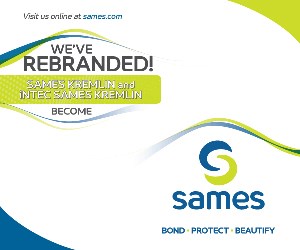Powder Coating Q&A: Powder Coatings for Outdoor
Can you tell me what powder we should consider, and how well it will meet the architectural specifications?
Q. We provide aluminum extrusions to the building industry for framing around windows and doors. We have been using liquid paint for many years, but we are interested in switching some of our product to powder coating. I want to better understand how powder performs on this type of product and how it compares with liquid coating for achieving AAMA specifications. Can you tell me what powder we should consider, and how well it will meet the architectural specifications?
A. AAMA has three different levels of performance defined in its specifications. AAMA 2603 is a modest performance specification that relates to one year of substantial color and gloss retention. AAMA 2604 raises weathering and other performance requirements substantially with a high retention of color and gloss for five years, and AAMA 2605 is the toughest requirement with a high retention of color and gloss for 10 years.
Meeting any of these specifications starts with the resin system used, regardless of whether the coating is a liquid paint or a dry powder. Acrylic and polyester coatings work well for most applications that require outdoor weathering resistance. With powder, you will most often see TGIC (triglycidyl isocyanurate) polyester powder that can be applied at different thicknesses and has excellent outdoor weathering characteristics.
Liquid paint offers different options depending on the performance requirements. Polyester is a good option for many products that will go into the 2603 and 2604 market, but it is not universally reliable for the 2605 standard. At that point, most coatings will be fluoropolymer products for both liquid and powder.
Can powder meet the lower levels of weathering associated with 2603 and 2604? Yes, it can meet those levels with most standard organic polyesters. They will be cost competitive and often lower in applied cost for 2604 products. In fact, some of the liquid options for 2604 have inferior mechanical properties and may require a primer coat to achieve the same performance as a single coat of powder. Some architects will specify a liquid fluoropolymer for 2604 applications with a single coat of TCIC powder. It is more expensive than the powder option, it has reduced mechanical wear compared with powder, and it has lower stain resistance. Some specifiers are not aware of the value associated with powder, and they are inclined to always go to a liquid.
A dry powder requires a well-prepared surface in order to adhere and provide maximum benefit. This is a marginal advantage for the liquid. Any aluminum surface that is going be used for an outdoor product should have a good treatment process to ensure long life, regardless of whether the coating is liquid or powder.
In general, powder is superior in cost and performance for the lower level of specification, and organic coatings in general cannot routinely meet the 2605 specification. Give powder a try. I think you will be pleased.
Originally published in the March 2016 issue.
Related Content
-
Calculating the Cost of Powder Coating
How can you calculate the cost of powder coating a component if you only know its surface area? Powder coating expert Rodger Talbert has the answer.
-
Products Finishing Reveals 2023 Qualifying Top Shops
Each year PF conducts its Top Shops Benchmarking Survey, offering shops a tool to better understand their overall performance in the industry. The program also recognizes shops that meet a set of criteria to qualify as Top Shops.
-
Adjusting Current and Voltage When Powder Coating
Which manual powder coating gun setting is better to adjust, voltage or current? Jeff Hale of Gema USA discusses when to use different settings on your powder gun to achieve optimal results.
















